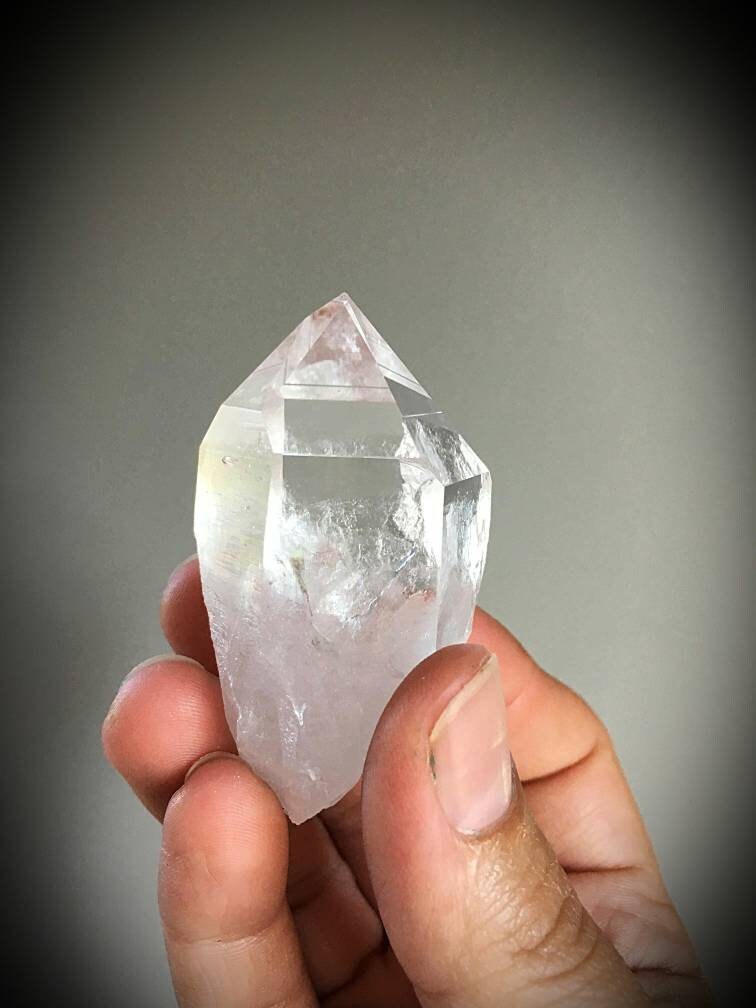
Pale lilac cactus quartz with some tinges of orange and red that is caused by hematite inclusions. The other major varieties of Quartz are Adventurine, Agate, Amethyst, Carnelian, Chalcedony, Citrine, Dumortierite Quartz, Jasper, Milky Quartz, Onyx, Rock Crystal=clear quartz, Prasiolite= green quartz, Rutilated Quartz, Smokey Quartz and Tiger’s Eye. The most common constituent of sand in inland continental settings and non-tropical coastal settings is silica, usually in the form of….quartz! Over 70% of the land we walk on is comprised of quartz or other silicates in one form or another. The color ranges from pale lilac to a deep purple known as amethystine. After feldspar, quartz is the second most abundant mineral in the Earth’s continental crust. Just like the rest of the quartz family, cactus quartz is comprised of silicon dioxide, has a trigonal crystal system and has a Mohs hardness of 7.0. Pale lilac candle shaped crystal. Hematite inclusions are responsible for the orange color. though I am most fond of Spirit Quartz.Ī nice example of secondary pale lilac and orange druse crystals that completely cover the primary Some people also refer to it as Porcupine Quartz. It is found only in the Magaliesberg Mountain region of South Africa. Its crystal structure is unique and distinctive from the rest of the quartz family forming a candle shaped crystal that has a faceted termination point that looks like the tip of a cactus and is surrounded by groups of smaller druse around the base or covering the entire candle shaped crystal. Only recently discovered in South Africa around 2001. Cactus Quartz has quickly become a favorite among rock hounds. Quartz oscillators are susceptible to frequency drift just like any other mechanical oscillator, with temperature one of the biggest culprits (just as it is in mechanical horology) and the most accurate quartz movements almost always incorporate some form of temperature compensation.Distinctive deep purple, (amethystine) with “cactus” structured crystals. On the other hand, you have ultra-high accuracy, high quality, built-to-last movements like the Grand Seiko 9F calibers, high-frequency movements like those used in the Longines VHP and Bulova Precisionist, and of course, the Citizen Caliber 0100, which is accurate to ☑ second per year.

At the very lowest end you have stamped metal, unjeweled movements which can keep time to, at best, ☑5 seconds a month (still much better than many mechanical watches, though). However, just as with mechanical watches, there are wild variations in quality. Quartz watches may seem like soullessly infallible devices, with about as much romance compared to mechanical watches as a cruise missile has with an elegantly wielded rapier. The most accurate watch in the world, the Citizen 0100, has a specially cut quartz crystal with a frequency of 8,388,608Hz – the 23rd power of 2, as it happens. Improvements in accuracy in watches and clocks is largely the story of the pursuit of higher frequencies, from 36,000 vph high frequency mechanical movements, to tuning fork movements like the Accutron, to quartz watches. Now, it is certainly true that a very high quality mechanical watch stands an excellent chance of outperforming a lower quality quartz watch, but the laws of physics describing rate stability in oscillators are squarely on the side of quartz.

The frequency of the oscillator is much higher than is possible for a conventional balance, and it's the key to the superior performance of quartz watches, all other things being equal. (32,768 is the 15th power of 2 so dividing the vibration into a single signal to increment the display is very simple). The timing circuit keeps track of the number of oscillations and when the number hits 32,768, the timing circuit increments the display (that's the other essential component) by one second. Quartz watches are generally designed to vibrate at a frequency of 32,768Hz.


 0 kommentar(er)
0 kommentar(er)
